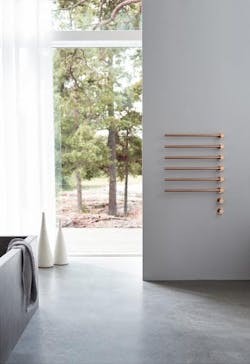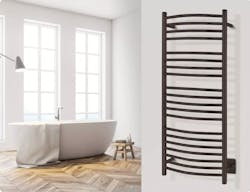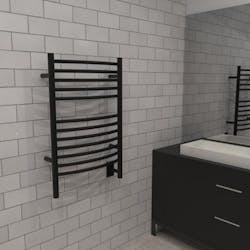Is It Time to Consider Spa Towel Warmers for Your Bathrooms?
Towel warmers (also known as heated towel racks) are common amenities in European hotels and homes, but up until recent years, they have not had strong penetration in U.S. market. Things could be changing.
Electric bathroom towel warmers are wall-mounted products that consist of rails to heat towels or bathrobes. Commonly seen in spas, a towel warmer is a luxurious, some might say decadent, feature that is useful and appreciated in cold climates.
People who are fans of towel warmers say the units ensure that homeowners have a warm towel or bathrobe after a shower or a dip in the pool. The products also allows towels to dry out faster, which reduces laundry loads and water consumption, they say. A warmer also will help prevent towels from giving off a musty or mildewy smell that occurs when they are not dried properly.
The top five markets towel markets in the world are the United States, China, Germany, Japan, and France. In 2019, Europe dominated the towel warming market with a share of 47.7%, Grand View Research says in an August 2020 report.
[ Read More: What’s Trending in Kitchens, Baths? Ferguson Has the Answer ]
The Vola T39 modular towel warmer system can be customize as clients need. All mechanical components are concealed behind a wall. The product is available in 27 finishes.
“The presence of international companies and higher adoption of towel warmers in the region are acting as major factors for market growth,” theSan Francisco-based company writes in the report. “Extreme weather conditions need for heating equipment in washrooms, and demand for efficient energy solutions are the major factors behind the higher adoption rate of the product in the region.” Additionally, increased product launches, innovation in product offerings, and the growing hospitality industry are boosting the market growth.
And the towel warming market is expected to grow at a compound annual growth rate of 6.8% from 2020 to 2027. “Growing economic activities, increasing urbanization, and home remodeling activities are acting as major factors for market growth,” the report says.“Growing awareness among consumers regarding the growth of germs in a wet towel is also acting as a catalyst for market growth.”
Though Europe leads the world in its adoption of towel warmers, demand is growing in the United States, especially in the commercial sector, which dominated the market with a share of 69.4% in 2019. Rising economic activities, increase in the number of spas, and hotels, and growing tourism are boosting demand in the commercial sector--though the worldwide pandemic is likely to slow down growth.
[ Read More:WarmlyYours Launches New Line of Electric Towel Warmers ]
The Cosmopolitan Collection by WarmlyYours is a line of wall-mounted towel warmers features 10 unique variants from seven new models. Unike it's other products, the line is only available for purchase from authorized dealers.
But the residential market is looking up, Grand View says. The sector is expected to expand at the fastest CAGR of 7.0% from 2020 to 2027. There are many factors causing this increase: More American consumers are being expose to towel warmers in spas and while staying in European hotels. There is another cause. “Increasing urbanization is acting as a major factor in the growth of the segment,” Grand View says. “Demand for towel warmers in the residential sector is driven by increasing urbanization and rising expenditure on home remodeling.”
Towel warmers can be either hydronic or electrical. Hydronic systems are more energy efficient and do not contain any electrical parts, but they’re also more complicated to install. Hydronic towel warmers also function only when the heating system is on.
Electric models dominate the U.S. market. They generate heat in one of two ways. Some contain an oil or glycol-and-water solution that is heated with a filament, while dry-element models use a thick electric cable that runs through the entire appliance. Dry-element towel warmers preheat quickly— in 10 to 20 minutes—but, unless it’s a bad switch, can be more difficult to repair.
By contrast, repairing a fluid-filled model often entails simply changing out a spent heating element, even after a decade of use. But it can take take 30 to 45 minutes to heat up, depending on the size.
[ Read More:7 High-Tech Smart Toilets That Will Elevate Your Master Bathrooms ]
The Jeeves electric towel warmer collection from Amba Products features a classic towel bar design with featuring liquid-filled round bars. It boasts automatic heating technology with a built-in thermostat, so all models self-regulate to maintain the ideal internal temperature range and reduce power consumption.
Some users prefer to keep their electric towel warmers running continuously, which ensures towels will be warm all day long and helps prevent mold and mildew in towels.While this may seem like an easy way to increase monthly utility costs, manufacturers claim this consumes less energy than a 100-watt light bulb. One way homeowners can reduce the costs is by connecting the towel warmer to a timer. Running the unit from, say, 5 am to 8 am, is much more efficient.
Advocates say one way homeowners can think of the towel is as supplemental space heating. The heat the unit produces can warm a space and reduce demand from a home’s central heating system, so it’s not totally wasted energy.
“Heated towel racks do more than just provide warm towels,” says Peter Manidis, marketing manager at towel warming distributor Amba. “They’re energy efficient dryers, allowing users to dry wet items in between loads, meaning better air quality through mold reduction and fewer loads of laundry, thus saving on time and resources.”
The question remains: Is it worth it to install towel warmers in your homes? Designers and manufacturers say definitely. They are not that expensive, costing just between $149 and $500, radiant heat manufacturer Warmlyyours says, and not that expensive to use.
“To operate the unit, it typically costs only pennies a day because the units have very low energy consumption,” WarmlyYours writes on a company blog. “Based on the national average electricity rate, the cost of operation is about 15 cents per day, but the cost will vary depending on the price of electricity in your area.”
[ Read More: Sterlingham Debuts Single Rail Towel Warmers ]
Warmup's Liberty Single Bars can be customized by the number of bars and the space between each bar. It measures 23⅝ inches wide and consumes 9 watts. TIt cam be wired to the company’s 4iE Wi-Fi thermostat.




